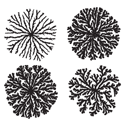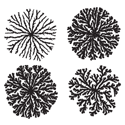Branching out
Processes as diverse as the growth of dendrites and the evolution of bacterial colonies follow patterns that involve the formation of branches. So far, most theoretical attempts to describe branching in these types of systems simplified the problem by assuming the internal structure of the branches could be disregarded. But nature is not so simple. In fact, there are numerous examples—blood vessels, the air ducts in lungs, leaf veins—where the properties of the individual branches influence the overall growth. This is particularly evident in the context of neuronal networks, where the birth and strength of new synaptic connections both affects and responds to the electrical activity of the entire network.
In a paper appearing in Physical Review E, Ikuko Motoike and Hisako Takigawa-Imamura at Kyoto University, Japan, tackle this problem by proposing a so-called cellular-automaton approach that allows “feedback” between the growth of branches and the dynamics of signals that pass through the entire network. As a result, the authors find the spontaneous generation of signals, which affect the overall network shape and, depending on the parameters they choose, give rise to a large variety of different structures. The challenge for future studies will be to clarify the correlation between path deformation and signal propagation, as a first step in understanding signal processing where feedback plays an important role. – Antonio Politi





